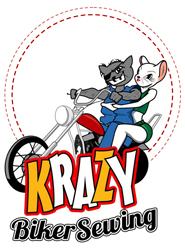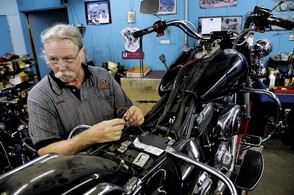Charles Coleman can replace worn brake pads and tires, but how the owner rides a Harley is beyond his control.
“As far as the safety stuff, we try to take care of the motorcycle,” said Coleman, owner of Coleman Motorcycle Company in Dothan, Alabama. “We can’t work on the customer.”
Coleman worked for 20 years as a mechanic for Harley-Davidson before opening his own shop. He said there are a lot of safety-minded people out there, but some riders find it hard to take advice.
“I don’t need to tell them how to ride, how to steer, how to brake, because that’s not what I do,” Coleman said. “I let people who do that for a living do that.”
Courses are available, and if riders heed the advice instructors offer it can cut down on mishaps on the road. Three Wiregrass residents have died in motorcycle crashes in the last month.
“The biggest problem in the state of Alabama is there’s no mandate for rider education and training,” said Rick Randolph, manager of the Alabama Motorcycle Safety Program, part of the Alabama Traffic Safety Center based at the University of Montevallo. “Alabama is the only state in the nation and only property of the nation that doesn’t have a skills test to get a motorcycle endorsement.”
In Alabama, a rider only has to take a written test to get a motorcycle classification on their license. “People that renewed or were issued an Alabama license in the 1991-92 timeframe were just grandfathered in to a motorcycle endorsement,” Randolph said.
He points to the vast difference in the number of licensed riders and the number of registered motorcycles. “In the state of Alabama, there are over 1.8 million licensed motorcyclists,” Randolph said. “The last numbers that I saw reported showed that there were 120 some odd thousand registered motorcycles.”
A law to require a skills test hasn’t been a high priority for elected state officials.
“I’ve been working pretty aggressively with the state Legislature for the last three years, and I know that’s gone on at least five years before my arrival here,” Randolph said. “It’s just not something that wants to be addressed. Recent events may lend some weight to our complaints.”
Acquiring the skills and experience to avoid dangerous situations is one way riders can be safer. Beyond the control of the rider is the chance that car and truck drivers don’t notice the motorcycle until it is too late.
“It is easy to lose a motorcycle in a backdrop that’s a cityscape or something that has a lot of activity going on behind the motorcyclist,” Randolph said. “People who don’t operate motorcycles, or don’t have friends or family members that operate motorcycles, when they’re out on the road they’re not looking for motorcycles.”
The program managed by Randolph conducts training at more than a dozen sites in the state, including Northview High School in Dothan.
The cost of the basic rider course, which lasts all weekend and is designed for new and novice riders using motorcycles, equipment and training materials provided by the center, is $250. The basic rider course 2, a one-day course for experienced riders that students take on their own motorcycles, is $85. Both courses cost slightly higher for out-of-state residents.
The second course can also be done with a rider and passenger for $110. Randolph said he is collecting data to determine if there is a need to add an advanced riding course.
“It does look like that’s something we’re going to offer next year,” Randolph said.
The basic course curriculum includes five hours in the classroom and 10 hours on a motorcycle, but during the hot July, August and September timeframes the time spent riding can be longer because instructors have riders take more breaks than what the Motorcycle Safety Foundation curriculum mandates.
The basic course is offered at least once a month in Dothan, Randolph said. “Our schedule runs from mid-April to mid-December,” he said.
For Danny Johnson, experience has been a good teacher. The Webb resident has put nearly 90,000 miles on his 1997 Honda Gold Wing since he bought it 11 years ago.
He said he hasn’t had any close calls during all that time. Johnson did recall one incident during a trip he made with his wife last year that carried them more than 10,000 miles around the country, from Dothan to Los Angeles and Seattle, over to New Jersey and back home.
On an interstate in Sacramento, Calif., they were following a truck when the truck driver slammed on his brakes.
“He actually ran over and knocked out of the lane a bed liner that had blown out of a pickup truck,” Johnson said. “He hit it and knocked it over to the emergency lane of the interstate.”
Because of the distance between the motorcycle and the truck, Johnson was able to slow down safely. “We never really were in any danger at all,” Johnson said.
Riders need to drive defensively to avoid situations, he said. “Definitely watch for other people and what they’re doing,” Johnson said, because drivers don’t always see a motorcycle coming.
He said riding just to the left of the center of the lane helps him avoid danger.
“If you go over to the side, the other edge of the road, that’s when people want to crowd you because you leave three-quarters of your lane open,” Johnson said.
“They want to pass you and be a quarter of the way over in your lane, and that’s not giving you enough room if anything happens to go wrong,” he said.
He follows the rules of the roads, such as using his turn signals and obeying the speed limit. He said car and truck drivers should give a motorcycle plenty of space so the rider has room to react.
“You can stop real quick on a motorcycle, and if they’re not looking when you put on brakes, they can run over you,” Johnson said. “Folks have a tendency to crowd you whenever they are behind you.”
He said motorcycle riders are definitely more vulnerable than car and truck drivers.
“If there’s a board laying across the road, or a brick, or something you don’t see and you hit it, it’s going to cause you problems,” he said. “If you fall, it’s going to hurt.”
Riders need to watch where they are going and keep their eyes on the road.
“You’re out there, and you don’t have any protection at all, so you want to do everything you can to protect you and your partner,” Johnson said.
He said his vigilance has paid off.
“We’ve seen a lot of country, a lot of miles, and been blessed with safety,” Johnson said.
Coleman knows all riders aren’t so careful. As a mechanic, he sees that some owners aren’t focused on eliminating risks.
He said a lot of people do the work on their motorcycles because they want to save money. “Everybody wants to be a motorcycle guy,” he said. “That’s part of owning one, to be able to fix it.”
Sometimes riders or their friends and neighbors don’t do a good job attaching accessories or making repairs. He said a bike may change hands a few times before an owner brings it to him “in foul shape,” with stripped-out holes and parts that don’t belong on a motorcycle.
“People try to do their own work to save a dime, and I try not to rub it in,” Coleman said. “I kind of let them know that ‘Hey, I could have done that for half of what your neighbor charged you and done a better job.’”
He said he checks parts that may not be on the repair list, because he’s watching out after his customers.
“I ain’t digging in your pocketbook, but if we see something unsafe, whether you want it fixed or not, we’re going to fix it,” Coleman said.
“We do our part by taking care of the vehicle so he ain’t riding around on a time bomb,” Coleman said. “I’m here to serve. I’m serving my customers that ride motorcycles.”


Leave a comment